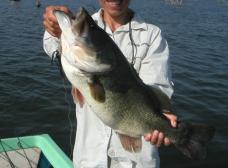Hunting big Bass
How does one define a BIG bass? To some a big bass will weigh anything from 2kg up, whereas others consider a big bass 4kg+.
To me a BIG bass is relative. It depends where you are fishing and what the average size of the resident bass are. For example, if you are fishing for bass in Zimbabwe, Botswana, KwaZulu-Natal, or any other warm regions notorious for producing large bass, a 2kg fish would be considered average. However, if you are fishing in Gauteng, Freestate or other cooler highveld regions, a 2kg+ bass would be considered big.
Personally? If the bass is large enough to get your juices flowing...it is a large bass. It doesn’t matter whether it is a 2kg bass or a 5kg monster.
Big bass are wily candidates and you need a good strategy if you want to consistently catch them. There are several factors to consider when targeting big fish. Add these together and your chances of catching big bass increase.
Habitat
Big fish do not move around much. Their age and experience has taught them the most ideal location for their survival, and they will stay in this area.
What is ideal ‘territory’ for big bass? Any area that can provide plenty of food, oxygen (moving water or aquatic plant life), cover and easy access to deep water, feeding flats and spawning areas
Forage
It is important to determine the predominant fodder for bass (species of bait fish, crustacean, or a combination of both) in the water you are fishing. In SA, forage would most likely consist of any of the tilapia or bream species, barbs (ghieliemientjie), carp (fry), crabs and freshwater invertebrates / crustaceans.
Big bass do not like to waste energy chasing down food. They will live in an area where food is abundant and where cover can be used for ambush.
Tackle
Once you have determined the main species of forage, use this knowledge to select your lures. ‘Match the hatch’ – a term often used by fly fishermen, is my number one guide to selecting lures when targeting big bass. What time of the year is it? Spring / early summer when bait fish are recently hatched and relatively small, or late summer / autumn when bait have had a whole season to grow into a decent size? Select your lure size and colour to match this season’s hatchlings.
Big bass often live in areas seldom targeted by fishermen because they are too difficult to fish and heavy with cover. You will need a stout rod and reel (heavy action), good quality line and hooks. Check your line / hooks often whilst fishing. Frayed line = lost fish. Hooks bent open = bad hookset. Trophy bass often only give you one chance for a good solid hookset. Don’t waste it.
Preparation
Take the time to study your target, the water you will be fishing and look for the right areas to fish. Do not waste time thrashing water. Learn to look at big water with a small water mind-set. Break down a large body of water into small areas, and fish each area as though it is a small pond. Determine where the feeding flats are, break lines, migration routes and deep water. Look for areas that = food + cover + escape route (deep water).
Mind-Set
Trophy bass anglers don't often catch a lot of small to medium sized fish because these are not the fish they are hunting. This is a quantity vs. quality situation. If you still get high on catching 50-60 bass a day then chances are trophy fishing is not your style yet. Hunting big bass may mean that you will only catch a couple of fish for the day, but those fish will be quality fish. Get your mind-set right before setting out on this quest.













0 Comments